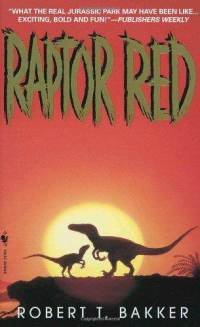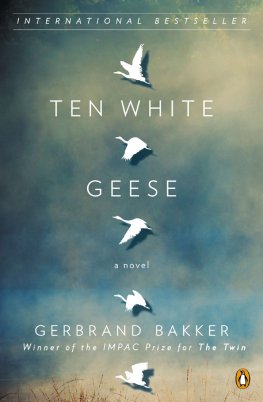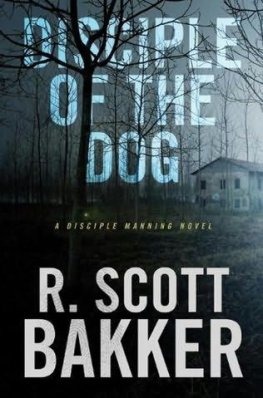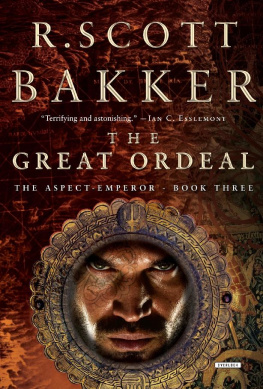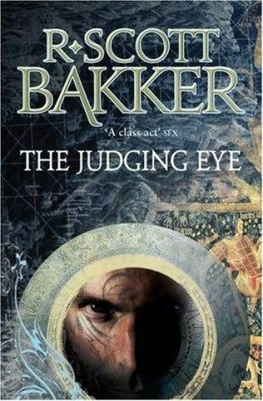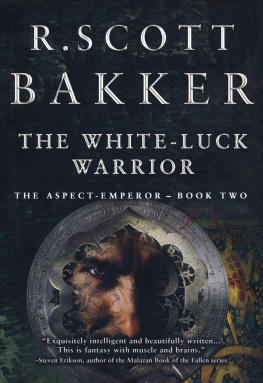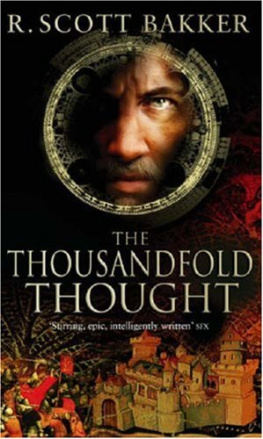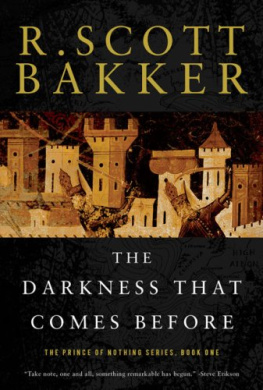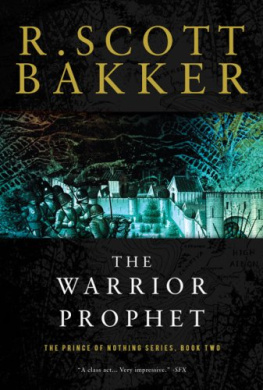R Bakker - The white-luck warrior
Here you can read online R Bakker - The white-luck warrior full text of the book (entire story) in english for free. Download pdf and epub, get meaning, cover and reviews about this ebook. genre: Romance novel. Description of the work, (preface) as well as reviews are available. Best literature library LitArk.com created for fans of good reading and offers a wide selection of genres:
Romance novel
Science fiction
Adventure
Detective
Science
History
Home and family
Prose
Art
Politics
Computer
Non-fiction
Religion
Business
Children
Humor
Choose a favorite category and find really read worthwhile books. Enjoy immersion in the world of imagination, feel the emotions of the characters or learn something new for yourself, make an fascinating discovery.

- Book:The white-luck warrior
- Author:
- Genre:
- Rating:5 / 5
- Favourites:Add to favourites
- Your mark:
- 100
- 1
- 2
- 3
- 4
- 5
The white-luck warrior: summary, description and annotation
We offer to read an annotation, description, summary or preface (depends on what the author of the book "The white-luck warrior" wrote himself). If you haven't found the necessary information about the book — write in the comments, we will try to find it.
The white-luck warrior — read online for free the complete book (whole text) full work
Below is the text of the book, divided by pages. System saving the place of the last page read, allows you to conveniently read the book "The white-luck warrior" online for free, without having to search again every time where you left off. Put a bookmark, and you can go to the page where you finished reading at any time.
Font size:
Interval:
Bookmark:
The white-luck warrior
Scott R Bakker
The heavens, the sun, the whole of nature is a corpse. Nature is given over to the spiritual, and indeed to spiritual subjectivity; thus the course of nature is everywhere broken in upon by miracles.
- Hegel, Lectures on the History of Philosophy IIIWHAT HAS COME BEFORE
Wars, as a rule, fall within the compass of history. They mark the pitch of competing powers, the end of some and the ascendency of others, the ebb and flow of dominance across the ages. But there is a war that Men have waged for so long they have forgotten the languages they first used to describe it. A war that makes mere skirmishes out of the destruction of tribes and nations.
There is no name for this war; Men cannot reference what transcends the short interval of their comprehension. It began when they were little more than savages roaming the wilds, in an age before script or bronze. An Ark, vast and golden, toppled from the void, scorching the horizon, throwing up a ring of mountains with the violence of its descent. And from it crawled the dread and monstrous Inchoroi, a race who had come to seal the World against the Heavens and so save the obscenities they called their souls.
The Nonmen held sway in those ancient days, a long-lived people that surpassed Men not only in beauty and intellect but in wrath and jealousy as well. With their Ishroi heroes and Quya mages, they fought titanic battles and stood vigilant during epochal truces. They endured the Inchoroi weapons of light. They survived the treachery of the Aporetics, who provided their foe with thousands of sorcery-killing Chorae. They overcame the horrors their enemy crafted to people his legions: the Sranc, the Bashrag, and, most fearsome of all, the Wracu. But their avarice at last betrayed them. After centuries of intermittent war, they made peace with the invaders in return for the gift of ageless immortality-a gift that was in fact a fell weapon, the Plague of Wombs.
In the end, the Nonmen hunted the Inchoroi to the brink of annihilation. Exhausted, culled of their strength, they retired to their underworld mansions to mourn the loss of their wives and daughters and the inevitable extinction of their glorious race. Their surviving mages sealed the Ark, which they had come to call Min-Uroikas, and hid it from the world with devious glamours. And from the eastern mountains, the first tribes of Men began claiming the lands the Nonmen had abandoned-Men who had never known the yoke of slavery. Of the surviving Ishroi Kings, some fought, only to be dragged under by the tide of numbers, while others simply left their great gates unguarded, bared their necks to the licentious fury of a lesser race.
And so human history was born, and perhaps the Nameless War would have ended with the fading of its principals. But the golden Ark still existed, and the lust for knowledge has ever been a cancer in the hearts of Men.
Centuries passed, and the mantle of human civilization crept along the great river basins of Earwa and outward, bringing bronze where there had been flint, cloth where there had been skins, and writing where there had been recital. Great cities rose to teeming life. The wilds gave way to cultivated horizons.
Nowhere were Men more bold in their works, or more overweening in their pride, than in the North, where commerce with the Nonmen had allowed them to outstrip their more swarthy cousins to the South. In the legendary city of Sauglish, those who could discern the joints of existence founded the first sorcerous Schools. As their learning and power waxed, a reckless few turned to the rumours they had heard whispered by their Nonman teachers-rumours of the great golden Ark. The wise were quick to see the peril, and the Schoolmen of Mangaecca, who coveted secrets above all others, were censured and finally outlawed.
But it was too late. Min-Uroikas was found-occupied.
The fools discovered and awakened the last two surviving Inchoroi, Aurax and Aurang, who had concealed themselves in the labyrinthine recesses of the Ark. And at their hoary knees the outlaw Schoolmen learned that damnation, the burden that all sorcerers bore, need not be inevitable. They learned that the world could be shut against the judgment of Heaven. So they forged a common purpose with the twin abominations, a Consult, and bent their cunning to the aborted designs of the Inchoroi.
They relearned the principles of the material, the Tekne. They mastered the manipulations of the flesh. And after generations of study and searching, after filling the pits of Min-Uroikas with innumerable corpses, they realized the most catastrophic of the Inchoroi's untold depravities: Mog-Pharau, the No-God.
They made themselves slaves to better destroy the world.
And so the Nameless War raged anew. What has come to be called the First Apocalypse destroyed the great Norsirai nations of the North, laying ruin to the greatest glories of Men. But for Seswatha, the Grandmaster of the Gnostic School of Sohonc, the entire world would have been lost. At his urging, Anasurimbor Celmomas II, the High-King of the North's mightiest nation, Kuniuri, called on his tributaries and allies to join him in a Holy War against Min-Uroikas, which Men now called Golgotterath. But his Ordeal foundered, and the might of the Norsirai perished. Seswatha fled south to the Ketyai nations of the Three Seas, bearing the greatest of the legendary Inchoroi weapons, the Heron Spear. With Anaxophus, the High-King of Kyraneas, he met the No-God on the Plains of Mengedda and, by dint of valour and providence, overcame the dread Whirlwind.
The No-God was dead, but his slaves and his stronghold remained. Golgotterath had not fallen, and the Consult, blasted by ages of unnatural life, continued to plot their salvation.
The years passed, and the Men of the Three Seas forgot, as Men inevitably do, the horrors endured by their fathers. Empires rose and empires fell. The Latter Prophet, Inri Sejenus, reinterpreted the Tusk, the First Scripture, and within a few centuries, the faith of Inrithism, organized and administered by the Thousand Temples and its spiritual leader, the Shriah, came to dominate the entire Three Seas. The great Anagogic Schools arose in response to the Inrithi persecution of sorcery. Using Chorae, the Inrithi warred against them, attempting to purify the Three Seas.
Then Fane, the self-proclaimed Prophet of the so-called Solitary God, united the Kianene, the desert peoples of the Great Carathay, and declared war against the Tusk and the Thousand Temples. After centuries and several jihads, the Fanim and their eyeless sorcerer-priests, the Cishaurim, conquered nearly all the western Three Seas, including the holy city of Shimeh, the birthplace of Inri Sejenus. Only the moribund remnants of the Nansur Empire continued to resist them.
War and strife ruled the South. The two great faiths of Inrithism and Fanimry skirmished, though trade and pilgrimage were tolerated when commercially convenient. The great families and nations vied for military and mercantile dominance. The minor and major Schools squabbled and plotted. And the Thousand Temples pursued earthly ambitions under the leadership of corrupt and ineffectual Shriahs.
The First Apocalypse had become little more than legend. The Consult and the No-God had dwindled into myth, something old wives tell small children. After two thousand years, only the Schoolmen of the Mandate, who relived the Apocalypse each night through the eyes of Seswatha, could recall the horror of Mog-Pharau. Though the mighty and the learned considered them fools, their possession of the Gnosis, the sorcery of the Ancient North, commanded respect and mortal envy. Driven by nightmares, they wandered the labyrinths of power, scouring the Three Seas for signs of their ancient and implacable foe-for the Consult.
Font size:
Interval:
Bookmark:
Similar books «The white-luck warrior»
Look at similar books to The white-luck warrior. We have selected literature similar in name and meaning in the hope of providing readers with more options to find new, interesting, not yet read works.
Discussion, reviews of the book The white-luck warrior and just readers' own opinions. Leave your comments, write what you think about the work, its meaning or the main characters. Specify what exactly you liked and what you didn't like, and why you think so.

